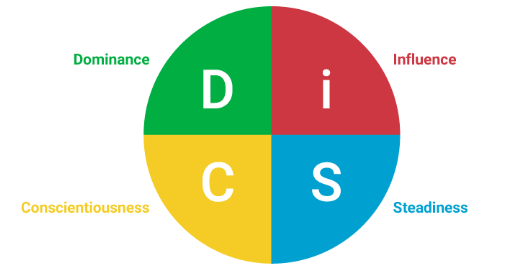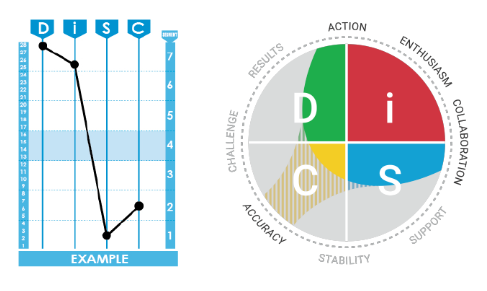
As you may know, DISC is a decades-old theory, which means there are other DISC providers out there. That means, depending on the model, DISC may not look quite the same from one entity to the next. So, how do we stand out from the crowd? At Everything DiSC®, we’ve dedicated ourselves to making our DiSC® assessment and learning experience as intuitive and user-friendly as possible. This of course includes the visual representation of each individual’s assessment results within our proprietary DiSC map.
Unlike other DISC providers, the precise results of an Everything DiSC personality assessment are represented through the DiSC® circumplex. This map allows each learner to inherently recognize and understand themselves and how they relate to others in the workplace.
circumplex
Noun
(plural circumplexes)
- A graphical representation, using polar coordinates, of the interactions of a central entity

How does the Everything DiSC® circumplex work?
So, why a circle? Well, apart from being an all-around good visual (pun intended), it was actually a very intentional choice on our part. Although the circular representation of DiSC is designed to be simple and intuitive, it also conveys a great deal of information about a person’s DiSC style at a glance. To start, the angular location of a person’s dot indicates the person’s primary DiSC style. Many people also lean toward a second DiSC style.
You can learn more on our research and the scales that help create a dot placement in our recent blog post. But it’s not just the placement of someone’s dot that’s important—there are several other factors that play an important part, too.
The importance of style inclination
A dot’s distance from the edge of the circle shows how naturally inclined a person is to encompass the characteristics of his or her DiSC style. A dot positioned toward the edge of the circle indicates a strong inclination toward the characteristics of the style. A dot located between the edge and the center of the circle indicates a moderate inclination. Finally, a dot positioned close to the center of the circle indicates a slight inclination.
For example, someone whose dot placement is on the fringe of the DC portion of the map will likely strongly identify with and present most if not all of the characteristics associated with the DC style—independent, difficult to read, skeptical—whereas someone whose DC dot placement is closer to the center of the map will only identify with and express some of these characteristics. It is important to remember that a dot in the center of the circle is no better than one on the edge, and vice versa.
What does shading mean?
While dot location and DiSC style say a great deal about a participant, map shading is also important. The eight words around the Everything DiSC map are called priorities, or the primary areas where people focus their energy. The closer a participant’s shading comes to a priority, the more likely they are to focus their energy on that area. Everyone has at least three priorities, and personalized shading indicates whether the participant stretches to include up to two additional priorities. These additional priorities are marked by striped shading, as shown below.

The idea of “stretch”
The continuous nature of the DiSC circle also helps people understand the idea of “stretch.” It is helpful to think of your style as your home base or comfort zone.
For years, consultants, coaches, and facilitators have used DiSC to help people recognize the occasional need to adapt their DiSC style to the people or situations around them. As mentioned earlier, the Everything DiSC profiles use shading to help participants understand the areas on the DiSC map where they might have difficulty stretching.
For instance, someone with a C style may be very comfortable working alone on analytical projects that require accuracy. At times, however, this person may be called on to mingle with strangers at a professional function. In this case, the person is being asked to stretch across the circle toward the i style. Now, someone with the C style who has a dot close to the center of the circle will probably find this mingling unpleasant, but manageable. On the other hand, someone with a C style whose dot is located on the edge of the circle is more likely to find this mingling highly stressful. In the second case, the person has had to travel farther outside their comfort zone, and that will require more energy.
This means, as a general rule, people with dots located close to the center usually have a somewhat easier time adopting foreign DiSC styles when the situation calls for it. People whose dots are on the edge of the circle may have to stretch more (and experience more stress) if they want to adopt another style. On the other hand, because these people have more pronounced DiSC styles, those styles are often accompanied by some very distinct strengths.
Understanding relationships through the DiSC model
One of the most powerful aspects of the DiSC circle is that it allows us to show the relationship between two people in a straightforward, visual manner. For instance, imagine Mina, a copywriter who has a D style, and Silas, a graphic designer with an i style. Mina can immediately see the similarities and differences between the two of them. Even though Mina and Silas both prioritize Action and may share a tendency to be fast-paced and outspoken, they also differ dramatically. Mina tends to focus on Results and Challenge, so she’s likely to be questioning and skeptical of other ideas while also being focused on the bottom line. Silas tends to value Enthusiasm and Collaboration and may focus more on getting everyone involved and building team spirit. In this case, Mina can see how she and Silas complement each other where they may share blind spots.
Although the line graph representation of DiSC allows us to compare the profile of two people, a great deal more interpretation and coaching is often necessary before the implications of that comparison become clear. With the circumplex, the implications and applications off the information are visually apparent. And while there is still a great deal of richness for a facilitator to add, participants can immediately begin to apply the information for themselves.
Integration of the four DiSC styles into the circumplex
Instead of presenting the four DiSC styles as four separate traits, as in the DiSC Classic example seen below (DiSC Classic preceded the Everything DiSC assessment and is also owned by Wiley), the Everything DiSC circular model on the right shows the true continuous nature of DiSC. Since the four DiSC styles do not live in isolation, the whole is greater than the sum of its parts.
For instance, there is a meaningful difference between someone who has a pure D style and someone who has a Di style. In each case, the D characteristics express themselves differently.
In the DiSC Classic assessment, the Classical Patterns are used to capture the integrated, interactive nature of the four styles. For instance, the Inspirational Pattern describes someone who is high in both the D and i styles and how these two styles uniquely combine to form the pattern. The circular representation of DiSC presents this integration, however, in a simple, visual manner.
Participants can clearly see how the different styles blend into one another (think of a color wheel) and where they fit within that blend.
Why the Everything DiSC circumplex is more memorable
One of the reasons that the DiSC model has been so successful over the years is because it gives people a simple, memorable way to understand themselves and those around them.
The DiSC profile could easily be designed to contain 20, 50, or even 100 different scales. And while such a profile might contain a lot of information, it would lose most of its practical usefulness—and keep people from internalizing the information. Think about it: if people have trouble organizing and remembering information, they won’t apply it.
Even though the line-graph representation of DiSC has proven to be incredibly powerful, the circular representation presents the DiSC model in a way that is even more intuitive and memorable without sacrificing the richness of information. Psychologists have long known that people can remember information much more easily when they chunk it together into smaller, unified pieces. With the circular model we are asking people to carry around in their heads one unified piece of information (i.e., the circular model) rather than four separate pieces of information (i.e., the four DiSC scales).
Although it may sound like splitting hairs, study after study shows the profound effects that chunking information has on memory. Consequently, if the Everything DiSC model is more memorable, it’s going to be more practical and useful. People will be more likely to successfully apply the model in their everyday lives.

Conclusion
In summation, the circumplex representation of DiSC opens up new possibilities for DiSC practitioners and learners alike. This representation allows participants to quickly understand the relationships in the DiSC model and recognize patterns within group dynamics. The Everything DiSC assessment also helps people quickly internalize the ways that they might need to stretch in their daily lives and the stress that this may cause. And perhaps most important, the circular representation makes the DiSC model more intuitive and memorable while maintaining (and building upon) its inherent richness.
